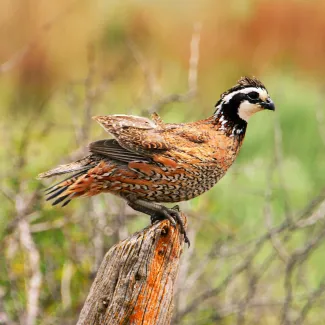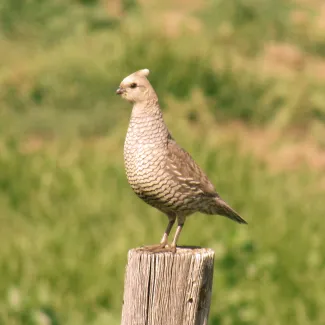Two species of quail can be found in Oklahoma—the northern bobwhite’s range is nearly statewide, while the scaled quail is restricted to the western edge, including the panhandle. Both species are ground-dwellers, primarily foraging on seeds and insects. Areas with high amounts of forbs can act as a food source in two ways—providing nutritious seeds, and attracting protein-rich insects. Though insects are seasonal in nature, forb seeds are long-lasting and can be utilized into fall and winter. Prime foraging or “bugging” areas have a wide diversity of forbs, including ragweeds, crotons, sunflowers, and legumes.

Northern Bobwhite Quail

Scaled Quail
In addition to a reliable food source, quail require adequate nesting, protective, and loafing cover. Though able to nest in a variety of places, quail prefer building nests in mature native bunchgrasses 12 inches in diameter and eight inches in height. Once chicks hatch, they are immediately moved to “weedy” areas with high insect activity. Morning and afternoon feeding sessions are separated by time spent resting and digesting food while in loafing cover. The ideal cover is at least three feet tall with a closed canopy and relatively open ground conditions; sand shinnery and sand plum motts are prime examples of this cover type. As quail travel from roost sites, to foraging areas, to loafing cover, woody vegetation is needed to serve as predator protection. These habitat components are best suited in a random mixture.
Oklahoma has a long quail hunting tradition. Even though population surveys show quail numbers are down over most of the state—a trend observed throughout the entire southeastern United States—Oklahoma is one of the few remaining states where hunters can pursue relatively large numbers of wild quail. Hunters have harvested an estimated 200,000 - 500,000 quail annually in Oklahoma over the last 5 years, which consistently ranks Oklahoma in the top three for harvest nationally.
2025 Quail Roadside Survey Quail Regulations 2025 Quail Season Outlook
HUNTING & SAFETY TIPS
Pagination
- Page 1
- Next page
CLEANING & PROCESSING TIPS
COOKING TIPS
Quail Research
The Oklahoma Department of Wildlife Conservation is involved in on-going bobwhite quail research projects in western Oklahoma. Research topics range from habitat and population dynamics to potential diseases.
Evaluation of Northern Bobwhite and Scaled Quail in Western Oklahoma
Research is currently being conducted on several WMAs around the state including: Sandy Sanders, Packsaddle, Cimarron Hills, Beaver River, Fort Supply, Ellis County, Black Kettle, Mountain Park, Drummond Flats, Hackberry Flat, Canton, Kaw and Cross Timbers.
If you harvest a banded quail, please email the information from the band to tell.judkins@odwc.ok.gov.
Quail Information
- Comprehensive Quail Habitat Guide
- Private Landowner Assistance Programs
- OSU's Habitat Appraisal Guide for Bobwhite Quail
- Quail Enhancement Program
- Prescribed Burning for Quail
- Guide to Plants Important for Quail
- Fall Covey Counts
- Upland Urgency: The Fight Against Bobwhite Quail Decline
- State of the Bobwhite Grassland Conservation at a Crossroad










